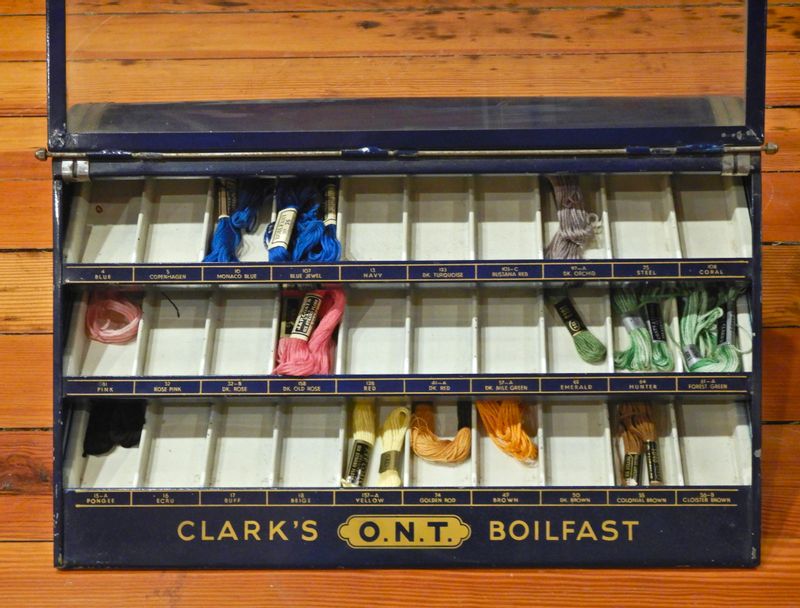A Thread Dispenser & the Submerged Culvahouse Store
Last Updated 3/21/2024
By Jubilee P. Reid

Under the waters of Watts Bar Lake lies the unincorporated community of Euchee. Named for the Euchee (or “Yuchi”) Native Americans of the Tennessee River Valley, this rural village in Meigs County was once the location of the Culvahouse General Store. This small country store was operated by Chester Arthur Culvahouse (1884 – 1960) in the early 20th century and was built close to his house surrounded by farmland. This rural store and farm provided the means for him to raise his 10 children. This changed, however, on January 1, 1942, when the gates of Watts Bar Dam closed, and the valley was flooded, including nearly 1,000 acres of Culvahouse land. Their large home, built in 1905, barely survived, having been built high on a hill which became a peninsula when the waters rose. The Culvahouse Store was submerged at the edge of the 39,090-acre lake.
The Tennessee Valley Authority had power of eminent domain and could therefore force any farm family to “sell” their land to be flooded by the TVA dams, even if the landowners refused. Many farm families did not want to see their generational lands, buildings, and cemeteries submerged forever under these lakes. Chester Culvahouse sued the government in complaint of the trifle amount of compensation his family received in exchange for so much of their livelihood. Photographs presented during the court proceedings depict his fields of corn which stood much taller than a person.
Among the collection of the McMinn County Living Heritage Museum is an item which was once in the Culvahouse Store. Displayed in the museum’s General Store Exhibit is a Clark’s O.N.T. Boilfast thread dispenser. It is believed to be from around 1930. This dark blue metal container features yellow lettering and measures 15 inches long, seven inches tall and nine inches deep. It has a hinged glass door for easy access to the 30 labeled slots for thread. Clark produced endless hues of thread; this dispenser has labels for such colors as “Monaco Blue,” “Copenhagen,” and “Nile Green.” It was donated to the museum in 1986 by Chester’s son James Dudley Culvahouse and Mrs. J. D. Culvahouse.
The Clark Thread Company has undergone many transformations since its beginnings. The company’s origins can be traced to 1755 in Paisley, Scotland when brothers James and Patrick Clark founded a silk thread and loom equipment business named Clark Thread Company. The town of Paisley was well-known for its production of silk and cashmere shawls in the early 1800s which had been popularized by Queen Victoria. Cotton thread was mostly nonexistent in Europe in the 1700s as silk and linen were the favored materials. The Napoleonic Wars (1803 – 1815) caused a shortage of silk in Britain forcing thread manufacturers to look for substitutes. In 1806, Patrick Clark invented a way of producing cotton thread as substitute for the lack of silk and in 1812 he opened a factory for production. The business prospered so well that in the 1840s, it extended to the United States. An American branch, Clark & Company, was formed by George Clark, a relative, in Newark, New Jersey in 1864. (Had Napolean known his blockade of Britain would cause the creation of an enormously profitable industry which saved British mills, he might have reconsidered.)
In the mid-1800s, Clark developed a six-strand thread especially for sewing machines. It was marketed as “Our New Thread” which was soon shortened to O.N.T. This thread became popular as sewing machines were becoming more widespread. In 1896 the American and British Clark companies merged with J. & P. Coats, another British thread firm founded in 1802 by James Coats. The merging of these powerful manufacturers created what would become the world’s largest producer of thread, continuing today as the Coats Group.
This conglomeration of thread manufacturers spread to over 50 countries and 6 continents. Extending sales to every community in America, their names became associated with quality thread. Textile scholar James R. Young stated that “every general store in the country found it as necessary to stock J. & P. Coats threads and the Clark "O. N. T." as to keep a cracker barrel.” The little Culvahouse Store was such a place.

